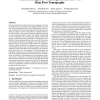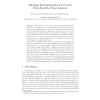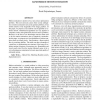99 search results - page 8 / 20 » The Complexity of Quantitative Information Flow Problems |
ESCIENCE
2007
IEEE
13 years 10 months ago
2007
IEEE
Scientific workflows have recently emerged as a new paradigm for representing and managing complex distributed scientific computations and data analysis, and have enabled and acce...
ASPLOS
2008
ACM
13 years 8 months ago
2008
ACM
It is not uncommon for modern systems to be composed of a variety of interacting services, running across multiple machines in such a way that most developers do not really unders...
RV
2010
Springer
13 years 5 months ago
2010
Springer
We describe a combination of runtime information and static analysis for checking properties of complex and configurable systems. The basic idea of our approach is to 1) let the p...
ICIP
2010
IEEE
13 years 4 months ago
2010
IEEE
Motion estimation is known to be a non-convex optimization problem. This non-convexity comes from several ambiguities in motion estimation such as the aperture problem, or fast mo...
BMCBI
2006
13 years 6 months ago
2006
Background: Signal transduction pathways are usually modelled using classical quantitative methods, which are based on ordinary differential equations (ODEs). However, some diffic...



